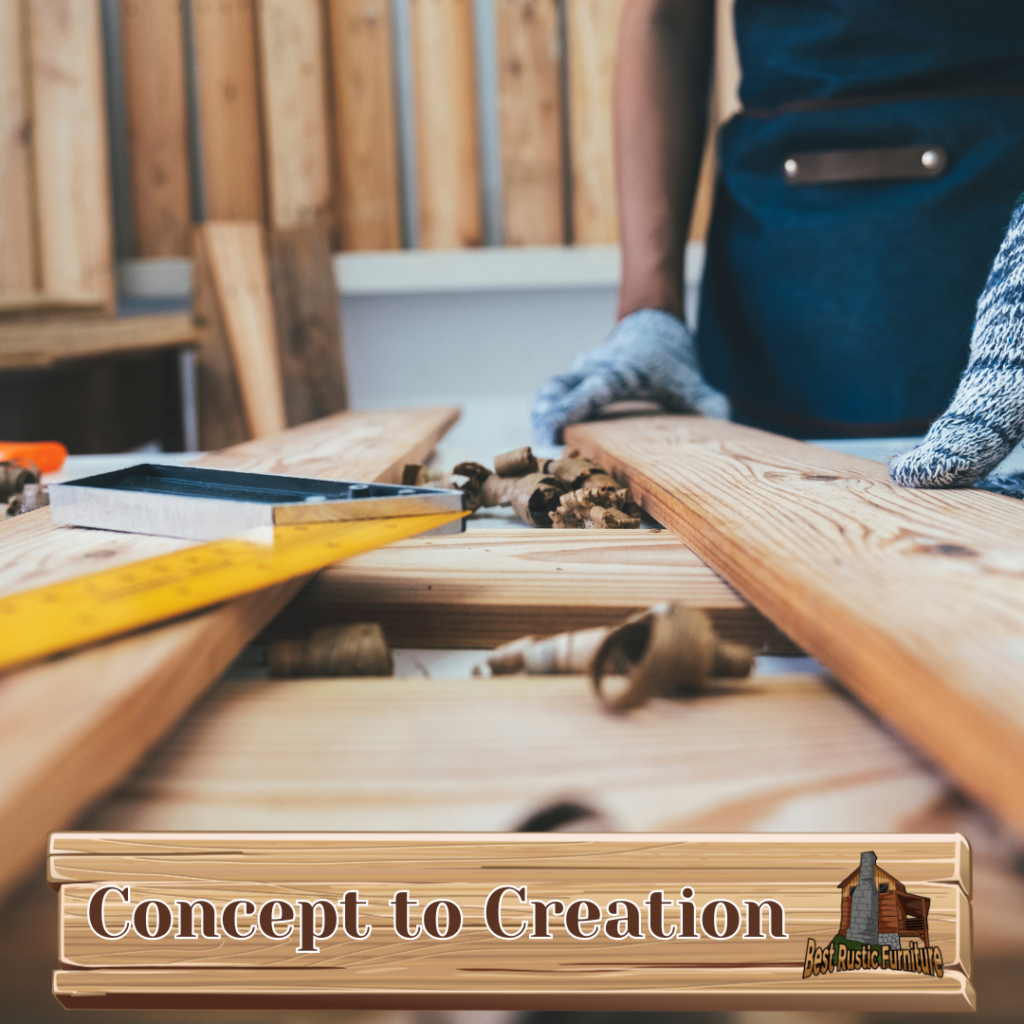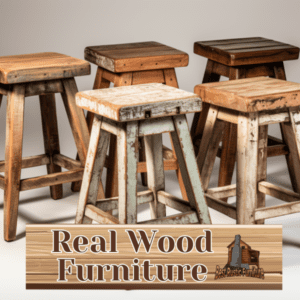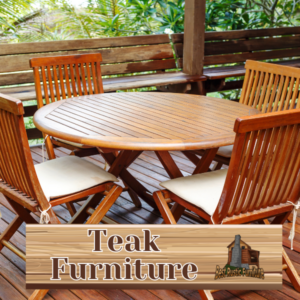
Custom rustic furniture is a unique and personal way to bring warmth and charm into any home or space. From the initial concept to the final product, the journey of crafting custom rustic furniture involves several phases that require meticulous planning and skilled craftsmanship.
This article will guide you through the entire process, highlighting key aspects of each phase and shedding light on the artistry and effort involved in creating one-of-a-kind rustic furniture pieces.
What is Custom Rustic Furniture? Custom rustic furniture refers to handcrafted furniture made from natural materials, such as wood and reclaimed materials, with a focus on incorporating rustic design elements. It embraces the organic, earthy qualities of wood and showcases the beauty of imperfections, knots, and unique grain patterns. Each piece is tailored to the client’s specific needs and preferences, resulting in a truly bespoke furniture creation.
The Conceptualization Phase Before the creation of any custom rustic furniture piece, the journey begins with understanding the client’s needs and vision. This involves engaging in thorough conversations, reviewing design inspirations, and considering the desired functionality, dimensions, and aesthetics. From there, design concepts are developed, taking into account the desired style, materials, and overall theme. Exploring material options is a crucial part of this phase to ensure that the chosen materials align with the client’s preferences and the intended rustic look.
The Planning and Preparation Phase Once the design concept is agreed upon, the planning and preparation phase begins. This phase involves precise measurement and space planning to ensure that the furniture piece fits seamlessly into its intended space. Estimating costs and creating a budget is an essential step to ensure that the project remains within the client’s financial parameters. Sourcing materials and equipment is also carried out during this phase to gather all the necessary resources for the construction process.
The Construction Phase The construction phase is where the magic happens, as the furniture piece starts to take shape. The work area is prepared, ensuring a clean and organized environment for the crafting process. Building the frame and structure involves expert craftsmanship, carefully assembling the individual components to create a sturdy and durable piece of furniture. During this phase, decorative elements unique to rustic design are added, such as distressed finishes, handcrafted accents, and intricate carvings, providing the final touches that bring the piece to life.
The Finishing Phase To enhance the beauty and longevity of custom rustic furniture, the finishing phase is crucial. Sanding and smoothing the surfaces ensure a polished and refined appearance, removing any roughness or imperfections. Staining or painting may be applied to achieve the desired color or tone, highlighting the natural beauty of the wood grain or adding a touch of personalization. Finally, protective coatings are applied, such as varnish or wax, to safeguard the furniture and enhance its durability.
Delivery and Installation Once the furniture piece is completed, it is carefully packaged and transported to the client’s location. Proper placement and assembly are carried out, ensuring that the furniture integrates seamlessly into its intended space. Attention to detail is crucial during this phase to guarantee a flawless and visually appealing installation.
Ongoing Maintenance and Care To keep custom rustic furniture looking its best for years to come, ongoing maintenance and care are essential. This may involve periodic cleaning, conditioning of the wood, and addressing any repairs or touch-ups as needed. By following recommended maintenance practices, the longevity and beauty of the custom rustic furniture can be preserved, allowing it to continue to be an enduring statement piece in any space.
Key takeaways:
- Understanding the client’s needs and vision: The conceptualization phase is crucial in custom rustic furniture design, as it involves understanding the client’s specific requirements and design vision.
- Choosing the right materials: Exploring material options is an important step in the planning and preparation phase, ensuring that the chosen materials are of high quality and suitable for the desired rustic aesthetic.
- Attention to detail in finishing: The finishing phase of custom rustic furniture involves sanding, staining or painting, and applying protective coatings. Paying attention to these finishing touches helps enhance the overall appearance and durability of the furniture.
The Journey of Custom Rustic Furniture
Crafting custom rustic furniture involves a meticulous journey that encompasses several steps. Here is an outline of the process:
- Conceptualization: Collaborate with the client to understand their vision and design preferences.
- Material selection: Choose high-quality wood and rustic elements that align with the desired aesthetic.
- Design and planning: Create detailed blueprints that capture the dimensions, structure, and functionality of the furniture.
- Construction: Skilled craftsmen bring the design to life, using traditional techniques and hand tools.
- Finishing touches: Apply stains, sealants, and protective coatings to enhance the wood’s natural beauty and durability.
- Delivery and installation: Safely transport and set up the custom piece in the client’s space.
Incorporating the authentic essence of history, the journey of custom rustic furniture, also known as “The Journey of Custom Rustic Furniture,” has been cherished for centuries. Each piece tells a unique story of craftsmanship and tradition. The journey weaves together the skills, creativity, and passion of artisans, resulting in timeless and one-of-a-kind masterpieces.
What is Custom Rustic Furniture?
Custom rustic furniture refers to furniture pieces that are handcrafted using natural materials and traditional techniques. These furnishings are characterized by their raw and unfinished appearance, often showcasing the natural beauty of the wood grain. Custom rustic furniture is tailored to the individual’s preferences and can be designed to fit specific spaces and needs. It provides a unique and timeless aesthetic, blending elements of nature and craftsmanship. The creation process involves understanding the client’s vision, designing concepts, selecting materials, and constructing the furniture with attention to detail. The end result is a one-of-a-kind piece that adds warmth and character to any space.
So, what is custom rustic furniture? It is a type of furniture that is handcrafted using natural materials and traditional techniques. This furniture style embraces the raw and unfinished look, highlighting the inherent beauty of wood grains. The customization aspect allows individuals to have furniture tailored to their preferences and needs, ensuring a perfect fit for their specific spaces. Custom rustic furniture brings together nature and craftsmanship, resulting in a distinctive and timeless aesthetic. Through a meticulous creation process that involves understanding the client’s vision, designing concepts, carefully selecting materials, and paying attention to detail during construction, each piece of custom rustic furniture becomes a unique masterpiece that adds warmth and character to any environment.
Custom rustic furniture has a rich history rooted in traditional craftsmanship and a deep appreciation for nature’s beauty. It originated centuries ago when people began forging furniture from the resources available in their surroundings. This style of furniture has endured the test of time and has evolved to reflect the changing tastes and trends. Today, custom rustic furniture embodies a desire for authentic, handmade pieces that bring a sense of warmth and character to modern homes. As we continue to appreciate the artistry and craftsmanship behind custom rustic furniture, it remains a prized possession for those seeking a connection to nature and a unique expression of their personal style.
The Conceptualization Phase
During the conceptualization phase of creating custom rustic furniture, we embark on an exciting journey where the client’s needs and vision come to life. We dive into the process of creating captivating design concepts and explore a wide range of material options. This crucial stage sets the foundation for transforming ideas into tangible and exquisite pieces. With a deep commitment to craftsmanship and attention to detail, this section uncovers the essential steps involved in bringing the concept of custom rustic furniture to fruition.
Understanding the Client’s Needs and Vision
Understanding the client’s needs and vision is a crucial step in the journey of creating custom rustic furniture. It involves actively listening to the client’s preferences, style, and desired functionality for the furniture piece. By taking the time to understand their needs, designers can ensure that the end product aligns with the client’s expectations. This understanding also allows designers to provide valuable input and suggestions based on their expertise. Ultimately, a collaborative approach that values the client’s input helps in creating a customized piece that perfectly reflects their vision and meets their requirements.
Creating Design Concepts
Creating design concepts is an essential part of the journey of custom rustic furniture. It involves translating the client’s needs and vision into tangible design ideas. Here are some steps to consider when creating design concepts:
- Understand the client’s preferences and requirements through thorough communication and collaboration.
- Gather inspiration from various sources such as magazines, online platforms, or previous projects.
- Sketch and visualize different design options, considering the overall style, functionality, and desired aesthetics.
- Explore material options that best align with the design concept, considering durability, sustainability, and visual appeal.
- Present the design concepts to the client for feedback and revisions.
Suggestions: Take the time to truly understand the client’s style and preferences to create design concepts that exceed their expectations. Consider incorporating unique and personalized elements to make the furniture truly one-of-a-kind. Always strive for a balance between functionality and aesthetics to create timeless and functional designs.
Exploring Material Options
When embarking on the journey of exploring material options for custom rustic furniture, it is crucial to take into consideration factors such as durability, aesthetics, and sustainability. Here are some essential materials you should consider:
| # | Material | Benefits |
|---|---|---|
| 1. | Wood: | To achieve an authentic rustic look, it is advisable to opt for reclaimed or salvaged wood. Choices like oak, pine, and cedar not only provide durability but also showcase the innate beauty of nature. |
| 2. | Metal: | To infuse a sense of strength and industrial charm, incorporating elements of metal such as iron or steel is recommended. |
| 3. | Natural fibers: | To introduce a touch of warmth and texture, consider exploring options like jute, hemp, or woven rattan for upholstery or decorative accents. |
| 4. | Stone: | Adding elements of stone like granite or slate as tabletops or accents can amplify the rugged appeal of your custom rustic furniture. |
| 5. | Leather: | Upholstering with high-quality leather not only ensures durability but also adds a touch of rustic elegance. |
By carefully considering and exploring these material options, it is possible to create bespoke rustic furniture that aligns with your design vision while prioritizing longevity and sustainability.
The Planning and Preparation Phase
In the intriguing world of custom rustic furniture, the planning and preparation phase sets the stage for an exceptional journey. Get ready to dive into the nitty-gritty details as we explore the art of measuring and space planning, the crucial task of estimating costs and creating a budget, and the exciting quest of sourcing top-notch materials and equipment. Each sub-section promises to unveil essential insights and practical tips that will fuel your passion for creating one-of-a-kind rustic masterpieces. So, let’s jump in and discover the secrets of this captivating phase!
Measuring and Space Planning
Measuring and space planning are essential steps in the process of creating custom rustic furniture. These steps ensure that the furniture fits perfectly in the designated space and maximizes its functionality.
- Accurate measurements of the space where the furniture will be placed are crucial for successful design. Consider the height, width, and depth of the area to determine the appropriate size for the furniture.
- Effective space utilization is important. Evaluate how the furniture will be used and plan accordingly. Consider factors such as storage needs, traffic flow, and any specific requirements.
- To create a harmonious and functional space, determining the optimal placement of the furniture is key. Take into account other elements in the room, such as existing furniture and architectural features.
By paying careful attention to measuring and space planning, you can ensure that your custom rustic furniture not only looks beautiful but also serves its purpose effectively.
Estimating Costs and Creating Budget
Estimating costs and creating a budget are essential tasks when it comes to developing bespoke rustic furniture. Here are some important factors to consider:
- Research: It is crucial to gather pricing information for materials, tools, and any additional services required for the project.
- Measurements: Accurately measuring the dimensions of the furniture is vital in determining the necessary amount of materials.
- Labor: Calculating the construction time and associated labor costs, especially if outsourcing specific tasks, is important.
- Extras: Accounting for additional expenses like hardware, finishes, or specialized tools that may be required.
- Contingency: Allocating a contingency fund for unexpected expenses or changes in the project scope is highly recommended.
By diligently estimating costs and creating a budget, you can ensure that your custom rustic furniture project remains financially on track. Remember to regularly review and adjust your budget as necessary throughout the process to avoid any financial surprises.
Sourcing Materials and Equipment
Sourcing materials and equipment is an essential step in the process of creating custom rustic furniture. Here are the key actions involved in sourcing the necessary materials and equipment:
- Conduct thorough research to identify reliable suppliers for the desired materials and equipment.
- Engage in consultations with suppliers to discuss specifications, quantities, and pricing.
- Carefully analyze and compare quotes from different suppliers and choose the most suitable ones based on both quality and cost.
- Efficiently place orders and coordinate delivery schedules to ensure timely availability of the required resources.
- Thoroughly inspect all incoming materials and equipment to verify their quality, quantity, and detect and address any potential defects.
- Implement proper storage measures to prevent any damage or deterioration of the sourced materials.
- Prepare and organize all the necessary tools and equipment required for the construction phase.
By diligently following these steps, sourcing materials and equipment can be accomplished effectively, thus guaranteeing the availability of high-quality resources for crafting custom rustic furniture.
The Construction Phase
Get ready to witness the magic unfold as we dive into the captivating world of custom rustic furniture. In this section, we will take a closer look at the construction phase, where dreams morph into tangible pieces of art. Join us as we explore the secrets behind preparing the work area, building the frame and structure, and adding those mesmerizing decorative elements and finishing touches. Brace yourself for a journey filled with creativity, craftsmanship, and the sheer joy of bringing ideas to life.
Preparing the Work Area
Preparing the work area is a crucial step in the construction phase of custom rustic furniture. Here is a list of steps to follow:
- Clean the workspace thoroughly, removing any dust, debris, or clutter.
- Organize the tools and materials needed for the project, ensuring everything is easily accessible.
- Set up a safe and ergonomic work environment, including proper lighting and ventilation.
- Take accurate measurements of the work area to ensure precise construction.
- Prepare any necessary surfaces, such as sanding or smoothing rough edges.
- Protect the surrounding area with drop cloths or tarps to prevent damage from tools or materials.
As a carpenter, I was once working on a custom rustic dining table for a client. Before beginning the construction, I meticulously prepared the work area by Preparing the Work Area, ensuring it was clean and organized. Taking precise measurements and smoothing the surfaces allowed me to create a flawless piece. By protecting the surrounding space, I prevented any accidental damage. The client was delighted with the final result, and this attention to detail during the work area preparation played a significant role in the success of the project.
Building the Frame and Structure
Building the frame and structure of custom rustic furniture involves several key steps:
- Measure and plan: Accurately measure the space where the furniture will be placed and plan the dimensions of the frame accordingly.
- Select materials: Choose the appropriate wood or other materials for the frame, considering factors such as durability and aesthetic appeal.
- Cut and shape: Use precise cutting tools to cut the materials into the required shapes and sizes for the frame and structure.
- Join and assemble: Use techniques such as dowel joints, mortise and tenon joints, or screws to securely join the pieces of the frame together.
- Strengthen and reinforce: Add additional support and reinforcement to ensure the frame is sturdy and can withstand weight and regular use.
- Test and adjust: Before adding decorative elements and finishes, testing the structure for stability and making necessary adjustments is vital.
When building the frame and structure, attention to detail and precision are crucial, as they contribute to the overall quality and longevity of the custom rustic furniture.
Adding Decorative Elements and Finishing Touches
When it comes to creating custom rustic furniture, incorporating decorative elements and finishing touches is crucial during the construction phase. These final details not only enhance the overall aesthetic appeal but also breathe life into the piece. Here are some important elements to consider:
- Hardware and embellishments: One of the key factors is selecting the right hardware, such as ornate hinges and handles, which can greatly elevate the furniture’s look.
- Carvings and engravings: Another way to add a unique touch and showcase the owner’s style is by incorporating intricate carvings or personalized engravings.
- Finishes and stains: Applying the appropriate finish or stain not only helps achieve the desired color and texture but also protects and enhances the beauty of the wood.
- Accents and fabric choices: To create a cohesive and polished look, it is essential to choose complementary fabric for upholstery or include decorative accents like nailhead trims.
For instance, a client once made a special request for a custom rustic dining table featuring hand-carved floral patterns along the edges. The skilled craftsman took meticulous care to carve each detail, resulting in a beautiful and personalized touch. To further highlight these exquisite carvings, the table was finished with a warm and rich stain. The end result was a stunning centerpiece that added charm and character to the client’s dining room. Needless to say, they were absolutely delighted with these final touches.
The Finishing Phase
In the final stretch of creating custom rustic furniture, we enter the exhilarating phase of finishing. Here, we breathe life into the raw materials and transform them into stunning pieces that will grace homes and spaces. Join us as we explore the artistry of sanding and smoothing the surfaces, the rich hues of staining or painting, and the safeguarding touch of protective coatings. Together, we’ll unveil the beauty and endurance that completes the journey of custom rustic furniture.
Sanding and Smoothing the Surfaces
To achieve a smooth and perfect finish on custom rustic furniture, the process of sanding and smoothing the surfaces is essential. Here is a step-by-step guide for this crucial phase:
- Start with coarse grit sandpaper to remove any rough spots or imperfections.
- Gradually shift to finer grit sandpaper to achieve a smoother surface.
- Sand in the direction of the wood grain for a more even finish.
- After sanding, use a damp cloth to remove any dust particles.
- Apply wood filler to fill in any gaps or holes in the wood.
- Once the wood filler has dried, sand the area again to ensure a seamless surface.
- Finish off by using a tack cloth to remove any remaining dust.
True story: A skilled craftsman, John, meticulously sanded and smoothed the surfaces of a reclaimed wood dining table. The hours of dedication and attention to detail paid off when the final product had a beautifully smooth and refined finish. The clients were thrilled with the result, as the table became the centerpiece of their dining room, showcasing the natural beauty of the wood. John’s expertise in sanding and smoothing brought out the true character of the rustic furniture, turning it into a timeless piece for generations to enjoy.
Staining or Painting
Staining or painting is a crucial step in the process of creating custom rustic furniture. Here are some key points to consider:
- Clean and prep the surface: Ensure that the surface is clean and free from any dust or debris before applying the stain or paint.
- Select the right stain or paint product: Choose a stain or paint that is specifically designed for wood surfaces to achieve the desired finish.
- Apply the stain or paint: Use a brush or roller to evenly apply the stain or paint, following the grain of the wood.
- Allow for drying time: Give the stain or paint sufficient time to dry according to the manufacturer’s instructions before applying additional coats or moving the furniture.
- Protect and finish: Consider applying a protective coating, such as a clear varnish or polyurethane, to protect the stained or painted surface and add durability.
Fact: Did you know that the right stain or paint can enhance the natural beauty of the wood and create a beautiful, personalized finish for your custom rustic furniture?
Applying Protective Coatings
- To ensure the longevity and durability of custom rustic furniture, applying protective coatings is an essential step. Here are the steps involved in this process:
- Clean the surface: Before applying any coating, make sure the surface is clean and free from dust, dirt, and debris.
- Sand the surface: Use sandpaper to smooth out any rough areas or imperfections on the furniture.
- Apply primer: A primer helps improve adhesion and enhances the effectiveness of the protective coating.
- Coat with protective finish: Using a brush or a spray gun, apply the protective coating evenly on the furniture surface.
- Allow drying time: Follow the manufacturer’s instructions for the recommended drying time before applying additional coats or using the furniture.
- Lightly sand between coats: For a smoother finish, lightly sand the furniture surface between each coat of protective coating.
- Apply additional coats (if necessary): Depending on the desired level of protection, apply multiple coats of protective finish, ensuring adequate drying time between each coat.
- Final curing and buffing: Allow the furniture to fully cure as per the manufacturer’s instructions. After curing, gently buff the surface to achieve a polished and smooth finish.
Delivery and Installation
When it comes to the journey of custom rustic furniture, one crucial aspect that ensures a seamless experience is the delivery and installation process. In this section, we’ll delve into the essential sub-sections of packaging and transportation, as well as proper placement and assembly. From the careful handling of each piece to the skillful arrangement in your space, we’ll explore how these steps contribute to bringing your unique furniture concept to life. So, buckle up as we navigate the crucial stages of delivering and installing your custom rustic masterpiece.
Packaging and Transportation
The packaging and transportation phase is a vital aspect of the journey of custom rustic furniture. It is essential to ensure proper handling and protection of the furniture to prevent any damage during transit. To safeguard the furniture, it is recommended to choose high-quality packaging materials including bubble wrap, cardboard, and furniture blankets. Using sturdy boxes or crates that offer ample space and support for the furniture is crucial. Additionally, it is important to securely fasten the packaging with strong tape or straps to prevent any shifting or movement during transportation. To ensure easy identification, each package should be clearly labeled with detailed information. When selecting a moving company, it is advised to opt for a reliable and experienced one that specializes in furniture transportation to ensure the safe delivery of the items. As a pro-tip, taking photographs of the furniture before packaging can serve as a visual reference in case of any damage claims.
Proper Placement and Assembly
- Properly prepare the space by clearing the area where the furniture will be placed to ensure enough room for proper assembly and movement.
- Thoroughly inspect the furniture, checking the components, hardware, and instructions to ensure everything is in order before starting the assembly process.
- Follow the provided assembly instructions carefully, taking note of any specific requirements or precautions.
- Organize and gather all the necessary tools and equipment needed for the assembly to ensure easy accessibility.
- Begin by assembling the main frame or structure of the furniture, following the step-by-step instructions provided.
- Ensure the stability and security of the furniture by checking and tightening all screws, bolts, and connectors.
- Once the furniture is fully assembled, add any decorative elements or finishing touches according to the instructions.
- Perform a stability test to ensure that the furniture is properly balanced and securely assembled.
- Carefully position the furniture in the desired location, ensuring that it is level and aligned correctly.
- If necessary, make any final adjustments or tweaks to ensure proper placement and alignment of the furniture.
Ongoing Maintenance and Care
- Proper ongoing maintenance and care are essential for preserving the beauty and longevity of custom rustic furniture.
- Here are some important steps to follow to ensure ongoing maintenance and care:
- Dust regularly: Use a soft cloth or brush to gently remove dust from the furniture.
- Protect from direct sunlight: Avoid placing the furniture in direct sunlight to prevent fading and warping.
- Avoid moisture exposure: Wipe up any spills immediately and use coasters or mats to protect the surface from water damage.
- Apply wax or polish: Regularly apply a suitable wax or polish to keep the wood moisturized and protected.
- Inspect for damages: Regularly inspect the furniture for any damages or wear and tear and address them promptly.
Pro-tip: Use furniture covers or blankets to protect the furniture during periods of extended non-use or when moving it to a new location. This will help ensure ongoing maintenance and care and prevent scratches and other damages.
Some Facts About “The Journey of Custom Rustic Furniture: From Concept to Creation”:
- ✅ Ken and Emily Williams started their custom hardwood furniture business in 2012 in McKinney, Texas.
- ✅ Rustic + Modern Handcrafted Furniture was established by Ken and Emily in 2015.
- ✅ The company focuses on creating meticulously-made products designed to inspire.
- ✅ Rustic + Modern Handcrafted Furniture has received numerous five-star reviews.
- ✅ The company has won the Houzz Customer Service Award multiple times.
Frequently Asked Questions
FAQs about the Journey of Custom Rustic Furniture: From Concept to Creation
1. How does YouTube work in the context of making rustic furniture?
YouTube offers a platform where makers of rustic furniture can share their skills and knowledge through videos. It allows them to showcase their craftsmanship, techniques, and creative ideas to a wide audience.
2. How can I test new features on YouTube?
To test new features on YouTube, you can participate in beta programs or join YouTube’s Creator Insider program. These opportunities give you early access to experimental features and a chance to provide feedback.
3. How can I terminate a contract for custom rustic furniture?
To terminate a contract for custom rustic furniture, you should refer to the specific terms of the contract. It is essential to follow the termination clauses and communicate your intent to terminate the contract to the relevant parties involved.
4. What are the options for future clients when it comes to rustic bedroom decor?
Future clients looking for rustic bedroom decor have various options available. They can explore custom-designed rustic beds, dressers, barn doors, and other decor pieces offered by reputable rustic furniture companies.
5. How important are the terms of use and privacy guidelines for rustic furniture businesses?
The terms of use and privacy guidelines are crucial for rustic furniture businesses to establish trust and protect their customers’ privacy. These policies outline the rules, rights, and responsibilities associated with using their services or sharing personal information.
6. How do custom rustic furniture businesses keep up with changing trends?
Custom rustic furniture businesses keep up with changing trends by staying updated with industry news, attending design events, and listening to customer feedback. They also analyze market demands and incorporate new design elements or styles to cater to evolving customer preferences.






